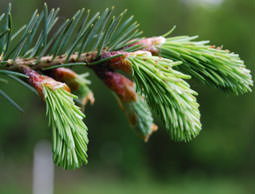
Courtesy American Livestock Breeds Conservancy
The Spanish goats located off the coast of South Carolina possess rare genetic adaptations to the local climate. |
The American Livestock Breeds Conservancy has completed the first phase of rescuing an isolated population of Spanish goats on an island of the coast of South Carolina. This population is one of only two strains of Spanish goats known to exist in the Southeast. The goats’ genetics are extremely valuable to the Spanish goat population as a whole, which currently numbers less than 7,500 animals in the United States.
This specific Spanish goat population has adapted to the challenges of the hot, humid, swampy environment of the Southeast for 500 years. These adaptations are unique among Spanish goats.
“Spanish goats are important as one of the main landrace representatives in the U.S. for the goat species,” says Phil Sponenberg, PhD, a professor of pathology and genetics at Virginia Tech University. “As is true of landrace livestock, they tend to be adapted and productive in compromising environments. The southeastern representatives of the landrace are extremely important, because these are the very ones expected to have the most inherent resistance to parasites and other environmental challenges. These few remaining herds are extremely important to save as an intact genetic resource.”
Due to inbreeding and predation, the South Carolina Spanish goat population is threatened with extinction. Thirty years ago, there were more than 100 Spanish goats on the island. Today, fewer than 30 remain. Removing selected goats from the population and placing them into a conservation breeding program will help promote the survival of this unique strain.
On May 15, ALBC staff members Jeannette Beranger and Marjorie Bender traveled to South Carolina to complete the initial phase of the goat removal process. Previous trips ensured the Spanish goat herd was documented and photographed. Photos were then evaluated by Sponenberg, the ALBC’s technical advisor, to determine Spanish phenotype and to identify target conservation goats prior to beginning removal.
ALBC staff members educated the local community about the Spanish goat breed and the process for removing the animals.
A local Native American group, Keepers of the Word, assisted with the rescue. The group consisted of teens and their leaders from the Keepers of the Word “Venture Crew,” a scout group for teens with a focus on Native American principles.
“This was an opportunity to connect tribal members with animals they would have traditionally kept hundreds of years ago and incorporate them into the genetic rescue efforts,” says Beranger. “Ideally, one or more residents will want to become conservation stewards so the animals would literally return home, but to a safer environment.”
In the first phase of the rescue, two pregnant does were removed along with one doeling and one buckling. Members of Keepers of the Word assisted with moving the goats, while volunteers provided their boats for transport.

Courtesy American Livestock Breeds Conservancy
A Spanish goat buckling and doeling were rescued so they would not be targeted by predators. |
“This was a true service learning experience,” says Cathy Nelso, director of Keepers of the Word. “We’ve been trying to shed light on how DeSoto and other Spanish explorers impacted the tribes in our area, and these goats are a living legacy of that era.”
The rescued goats were brought to the mainland where they were documented. Hair samples were taken for genetic analysis, and the goats were moved into a large trailer for transport. The pregnant does were transported to Brookgreen Gardens, a sculpture garden and wildlife preserve just south of Murrells Inlet, S.C. Brookgreen Gardens agreed to work with ALBC to develop a conservation breeding herd from which satellite flocks can be established as numbers are increased. Brookgreen has several other rare breeds of livestock and provided more than 6 acres to house the goats. The proximity of Brookgreen Gardens to the island ensures the goats will be kept in a natural habitat similar to that of the island.
The young doeling and buckling that were removed are being kept by volunteers, as they require regular bottle feedings. Once they are able to browse and forage, they will be transported to Brookgreen Gardens to join the rest of the herd. According to ALBC, removal of the young goats was necessary to ensure they were not eaten by predators.
Select goats will continue to be removed and transported to Brookgreen Gardens. As the population grows, satellite flocks will be established.
“Following conservation breeding strategies will be critical to the survival of this line. The small population makes the challenge significant, but with the cooperation of satellite breeders and careful management, this strain and its unique adaptation to the hot, humid and marshy Southeast can be saved,” says Bender, ALBC research and technical programs director. “The goal of our efforts is to secure these animals and their genetics for future generations.”














